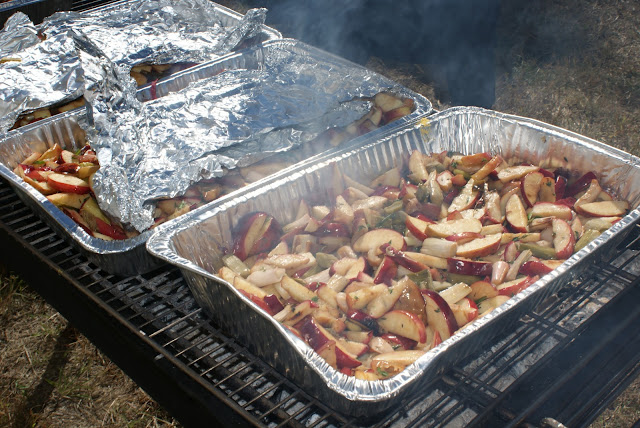My friend
Sarah and I got the chance to cover this event called Stored Potential for
The Reader, she as the art critic and I as the food person. The event brought together some of Nebraska's best chefs to serve 500 people family-style at the opening of a larger-than-life art installation. Thirteen of 300 submission were chosen to be printed on a large scale and hung from the side of some grain elevators in Omaha. The murals were chosen for how they addressed issues of feeding people and land use. The organization Emerging Terrain put on the installation and you can find better information about the art on their
Web site or by reading the part of the article that Sarah wrote when it comes out next week. I was only there for the food.
When we got there, I was immediatley filled with energy. I think everyone was. There was a table that stretched nearly the entire length of the silos (which are owned by some friends who are converting it in a rock climbing area called
SILO extreme outdoor adventure). I got to meet everyone I've written about and interviewed on the phone--all in one place. I even got to meet Jeanne of
Jeanne Eats World, who was there as a volunteer server.
The story Sarah and I wrote covers a lot of the ins and outs of the installation including what messages they're trying to send to morning commuters who see the silos as they drive downtown on Interstate 80. But, as always happens with something worthy of a great story, the story doesn't quite capture the enormousness of what it was. Even now I'm having a difficult time translating the events that transpired into something more than two dimensional.
The dinner brought the meat, poultry and produce of local farmers into the skills hands of local chefs who made this spectacular meal out of a bison, two whole pigs, 50 chickens and countless vegetables. The story describes the meal in a little more depth but doesn't go into the energy of the event. Everyone there was so excited about what was going on. The silos, which have been something of a horizon eyesore in the past, now have this art meant to emphasize the importance of knowing about our food. The area where the tables were arranged is on the city's plan for an extension of the Field Club bicycle trail. And the chef's and students were so excited to be sharing this phenomenal local food to 500 eager eaters.
I had so much fun running around interviewing attendees, chefs, farmers and organizers, getting everyone's story on why they were there and why they cared. I interviewed Chef Brian O'Malley who is the chef in charge of the culinary program at Metro, where I'm attended. He is such a magnetic force. He's got this great booming voice and when he talks to you no one else is there but you and him. I got to interupt Chefs
Matthew Taylor and
Paul Kulik who were in this heated post-dinner discussion of the process and how amazed they were with the quality of food they were given to work with. They were going on and on about how great each course was. Chef Taylor was raving about this vinegar. The entire day just made me so excited to be around such outstanding lovers of food and especially to get the chance to hear their stories. This blog post seems more scattered than what came out splitting the story. It's like I couldn't even wrap my mind around what was going on.
The site was so poetic in its past of feeding people mass quantities of food juxtaposed against a 500-something foot long table of people eating organic and ethically grown and raise cuisine. For a moment, I could even faintly smell the sweet odor let off by a nearby rendering plant. I wanted to put it in the story because I thought it was a little ironic to be celebrating local food while the remains of sick and abused animals were being made into commercial products nearby, but Sarah hadn't smelled it and thought it was a little dramatic--it's true, for a reporter, I definitely err
way too much on the meladramatic side. The truth should be strong enough.
Daily Grub's Chef Elle Lien's vegetable plate of roasted vegetables. (That sage just melted in my mouth.)
Roasted apples from Chef Kevin Shinn's (
bread&cup) and Paul Kulik's (
The Boiler Room) pork seven ways.
Chef Tim Shew of
La Buvette and culinary students from Metro serving up the pork with fruit and vegetables. (I was dying over those pickled radishes, dying.)
From left, Clayton Chapman of
Grey Plume, Mattew Taylor and Paul Kulik with culinary students.
I love this picture because you can tell the woman in the middle is a little nonplussed to be eating an
entire pig but the lady on the left is loving it.
Tim Shew plating the bison with green cabbage choucroute.
Chef Brian O'Malley showing a server how to get the champagne glaze all over the bison.
Apple crisp, honey ice cream and carrot cake for dessert.























































